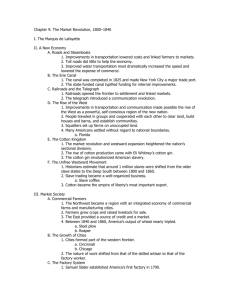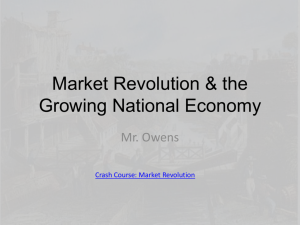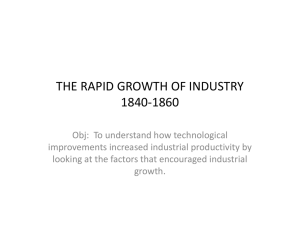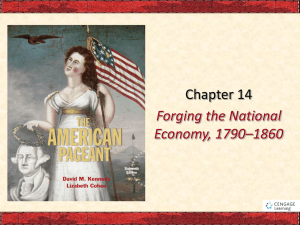Chapter_8_Toward_a_National_Economy
advertisement
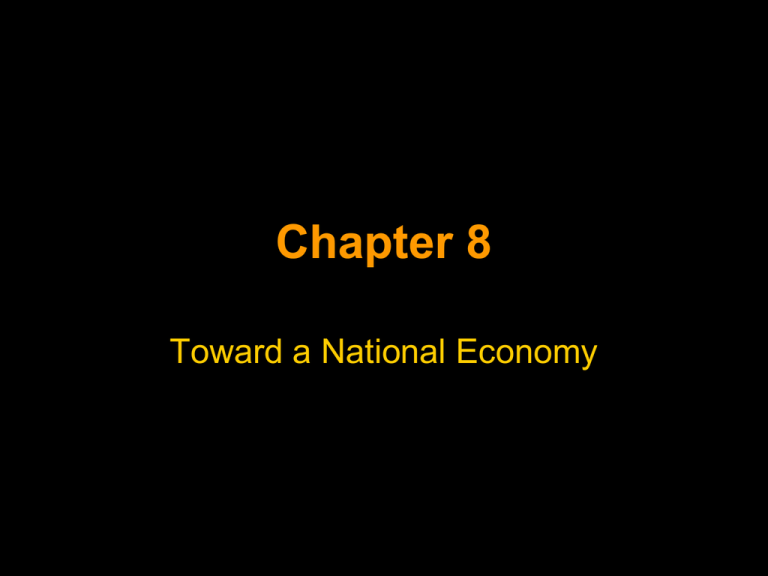
Chapter 8 Toward a National Economy Gentility and the Consumer Revolution • The democratic revolution was accompanied by widespread emulation of aristocratic behavior • In Europe, gentility was the product of ancestry and cultivated style • In America, gentility was largely defined by possession of material goods • This culture eventually extended even to frontier homes Gentility and the Consumer Revolution • Demand for products resulted in expansion of workshops, increase in numbers of artisans, and desire for laborsaving machines • Need for capital and ways to get raw materials to factories and products to consumers • Market revolution followed by industrial revolution Birth of the Factory • Industrial Revolution in Britain by 1770’s • Textiles – cheap and good quality • US wanted British technology – offered bonus • Britain guarded secrets of machinery Birth of the Factory • Samuel Slater Left England secretly Depended on memory to construct machines Helped establish first American factory in Rhode Island 1790 Birth of the Factory • First factory Only made cotton thread Cloth made by cottage industry Machines worked by nine children By 1812, 213 factories in existence • Francis Cabot Lowell Smuggled plans for power loom Waterpower Successful factory – changed face of New England An Industrial Proletariat? • Decrease in skilled labor = decrease in ability of workers to influence working conditions • Gap widening between owners/workers and skilled/unskilled workers • Very little class conflict. Why? • Labor – women and children. Good thing? Lowell’s Waltham System • Employed young, unmarried women Salaries $2.50 - $3.25 per week • Company boardinghouses Strict rules No cards or alcohol • Developed social life amidst factory Were not supporting themselves Established sewing circles Wrote periodicals and attended lectures Lowell’s Waltham System • Women made up 85 percent of workforce but no women in management • Some “strikes” protested lowered wages and rising boarding costs • By 1840’s, women moving to new jobs as teachers and clerks – mill jobs increasingly going to new Irish immigrants Irish and German Immigrants • US population doubled to 9.6 million between 1790 and 1820 through natural increase • After 1812, immigration increased dramatically • By 1850, US population 23 million – more than 10 percent immigrant • Most came from Germany and Ireland, but also from Britain and Scandinavia Irish and German Immigrants • Push and Pull factors – describe • Poor immigrants had to settle in eastern cities • Immigration stimulated the American economy • Irish caused resentment as they took jobs for lower wages Rise of Corporations • The modern method of organizing large enterprises was through corporations • General opinion that only public infrastructure were entitled to incorporation • Incorporation only possible through act of state legislature • Corporations equated with monopoly and corruption Cotton and the South • Demand fueled by Britain’s Industrial Revolution • 1786 - Introduction of “sea-island” cotton • South needed new commercial crop -hardy “green-seed” cotton not economically viable • Eli Whitney – cotton gin • High profits = more production – spread to other states Revival of Slavery • Cotton boom revived slavery • Concept of property rights held back many from demanding manumission • Increased fears of slave revolts – fear led to repression • Increased restrictions on free blacks. Why? Revival of Slavery • The Colonization Movement Black leaders saw colonization as way to escape discrimination – black nationalism White leaders either saw colonization as way to escape slavery – others did not want free blacks around (deportation) 1817- American Colonization Society founded Republic of Liberia established Little enthusiasm by blacks Revival of Slavery • Cotton boom put brake on movement – need for labor • Price of slaves doubled – severe decline of manumissions • Clandestine slave trade / increase in domestic trade • Pre-existing state laws barring inter-state slave trade ignored or repealed • Northern blacks experienced segregation Assignment 1 • Make a poster that shows Three problems facing America due to its primitive infrastructure Solutions introduced to enhance commerce Outcomes due to these solutions Use pages 235-243 Assignment 2 • How did the following court cases impact America? Use pages 244-245. Court Case Dartmouth College v. Woodward McCullough v. Maryland Gibbons v. Ogden Issue Involved Ruling Impact
